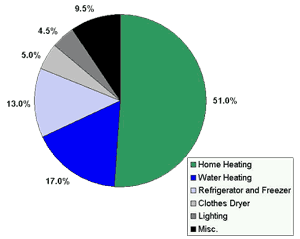 Electricity has no odor and can't be seen, so it is often puzzling where your energy dollar goes! While consumption patterns vary from home to home, we have some average consumption figures for home electric energy.
Electricity has no odor and can't be seen, so it is often puzzling where your energy dollar goes! While consumption patterns vary from home to home, we have some average consumption figures for home electric energy.
A kilowatt-hour (kWh) is a measure of electric energy consumed over a period of time. A watt is the amount of energy required to operate the electric device. To calculate the wattage of an appliance, multiply the voltage by the amperage. These values are typically found on the backside or bottom of the appliance or on the nameplate. To convert the watts to kilowatts, simply divide by 1000. Once you know the kilowatt value, multiply by the number of hours of operation to determine the kilowatt-hour consumption.
Where energy is used in your home:
|
Air conditioner |
1 kWh/sq. ft./year |
|
Car engine block heater |
.5 kWh/hour |
|
Clothes dryer |
5 kWh/load |
|
Dehumidifier (running continuously) |
16 kWhs/day |
|
Dishwasher |
1.5 kWh/load |
|
Freezer |
100-190 kWh/mo. |
|
Frost free freezer |
150-240 kWh/mo. |
|
Furnace (LP) winter months |
325 kWh/mo |
|
Lighting (varies) |
150 kWh/mo |
|
Microwave |
16 kWh/mo. |
|
Range |
100-150 kWh/mo. |
|
Refrigerator, standard |
120-150 kWh/mo |
|
Refrigerator, frost free |
200-275 kWh/mo. |
|
Television (4 hours/day) |
40 kWh/mo. |
|
Water heater |
125 kWh/person/mo |
|
Waterbed heater |
60-100 kWh/mo. |
|
Water pump |
1.5 kWh/1000gal |
|
Yard light |
|
|
.175 watt Mercury vapor |
73 kWh/mo. |
|
.90 watt Hi Pressure Sodium |
40 kWh/mo. |
The kilowatt hour consumption figures shown here are based on averages. Your consumption mayvary.

